
Today, at simultaneous press conferences around the world, including at the European Southern Observatory (ESO) headquarters in Germany, astronomers have unveiled the first image of the supermassive black hole at the center of our own Milky Way galaxy. This result provides overwhelming evidence that the object is indeed a black hole and yields valuable clues about the workings of such giants, which are thought to reside at the center of most galaxies. The image was produced by a global research team called the Event Horizon Telescope (EHT) Collaboration, using observations from a worldwide network of radio telescopes.
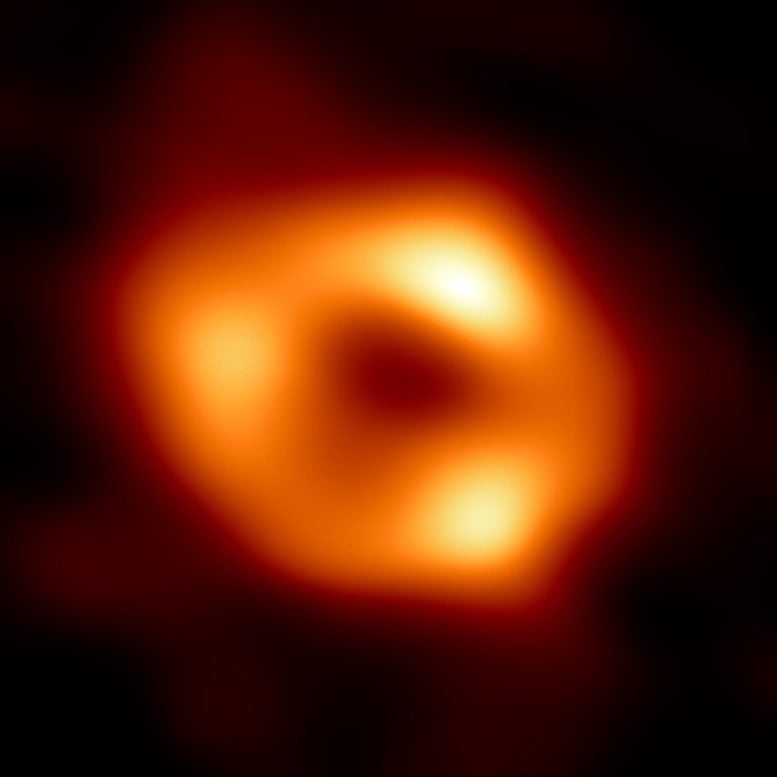
This is the first image of Sgr A*, the supermassive black hole at the center of our galaxy. It’s the first direct visual evidence of the presence of this black hole. It was captured by the Event Horizon Telescope (EHT), an array that linked together eight existing radio observatories across the planet to form a single “Earth-sized” virtual telescope. The telescope is named after the event horizon, the boundary of the black hole beyond which no light can escape. Credit: EHT Collaboration
The image is a long-anticipated look at the massive object that sits at the very center of our galaxy. Astronomers had previously seen stars orbiting around something invisible, compact, and very massive at the center of the Milky Way. This strongly suggested that this object — known as Sagittarius A* (Sgr A*, pronounced “sadge-ay-star”) — is a black hole, and today’s image provides the first direct visual evidence of it.
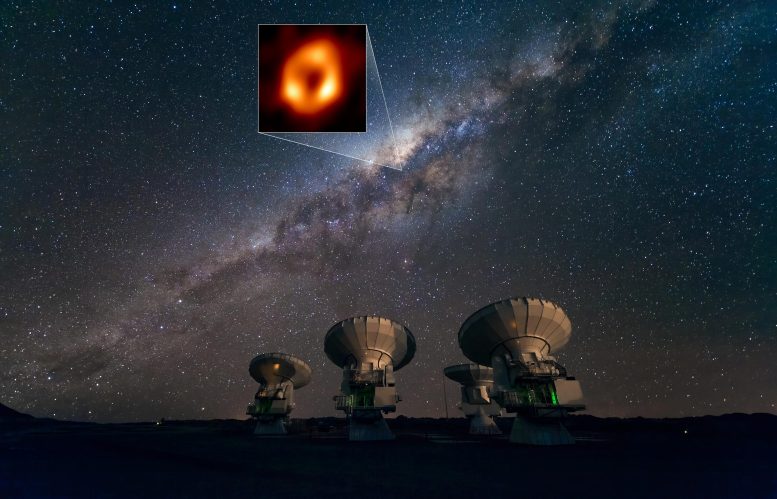
This image shows the Atacama Large Millimeter/submillimeter Array (ALMA) looking up at the Milky Way as well as the location of Sagittarius A*, the supermassive black hole at our galactic center. Highlighted in the box is the image of Sagittarius A* taken by the Event Horizon Telescope (EHT) Collaboration. Located in the Atacama Desert in Chile, ALMA is the most sensitive of all the observatories in the EHT array, and ESO is a co-owner of ALMA on behalf of its European Member States.
Credit: ESO/José Francisco Salgado (josefrancisco.org), EHT Collaboration
Although we cannot see the black hole itself, because it is completely dark, glowing gas around it reveals a telltale signature: a dark central region (called a shadow) surrounded by a bright ring-like structure. The new view captures light bent by the powerful gravity of the black hole, which is four million times more massive than our Sun.
Watch as this video sequence zooms into the black hole (Sgr A*) at the center of our galaxy. Beginning with a broad view of the Milky Way, we dive into the dense clouds of gas and dust at our galactic center. The stars here have been observed with ESO’s Very Large Telescope and ESO’s Very Large Telescope Interferometer for decades, the black hole’s immense gravitational pull distorting the orbits of the stars closest to it. Finally, we arrive at Sgr A*, the first image of which has been captured by the EHT collaboration. The black hole is shown by a dark central region called a shadow, surrounded by a ring of luminous gas and dust. Credit: ESO/L. Calçada, N. Risinger (skysurvey.org), DSS, VISTA, VVV Survey/D. Minniti DSS, Nogueras-Lara et al., Schoedel, NACO, GRAVITY Collaboration, EHT Collaboration (Music: Azul Cobalto)
“We were stunned by how well the size of the ring agreed with predictions from Einstein’s Theory of General Relativity,” said EHT Project Scientist Geoffrey Bower from the Institute of Astronomy and Astrophysics, Academia Sinica, Taipei. “These unprecedented observations have greatly improved our understanding of what happens at the very center of our galaxy, and offer new insights on how these giant black holes interact with their surroundings.” The EHT team’s results are being published today (May 12, 2022) in a special issue of The Astrophysical Journal Letters.
What does it take to capture an image of the black hole at the center of our galaxy? This video explains how the Event Horizon Telescope (EHT) works, and how astronomers managed to create one massive Earth-sized telescope big enough to “see” at the edge of black holes. Credit: ESO
Because the black hole is about 27,000 light-years away from Earth, it appears to us to have about the same size in the sky as a doughnut on the Moon. To image it, the team created the powerful EHT, which linked together eight existing radio observatories across the planet to form a single “Earth-sized” virtual telescope.[1] The EHT observed Sgr A* on multiple nights in 2017, collecting data for many hours in a row, similar to using a long exposure time on a camera.
In addition to other facilities, the EHT network of radio observatories includes the Atacama Large Millimeter/submillimeter Array (ALMA) and the Atacama Pathfinder EXperiment (APEX) in the Atacama Desert in Chile, co-owned and co-operated by ESO on behalf of its member states in Europe. Europe also contributes to the EHT observations with other radio observatories — the IRAM 30-meter telescope in Spain and, since 2018, the NOrthern Extended Millimeter Array (NOEMA) in France — as well as a supercomputer to combine EHT data hosted by the Max Planck Institute for Radio Astronomy in Germany. Moreover, Europe contributed with funding to the EHT consortium project through grants by the European Research Council and by the Max Planck Society in Germany.
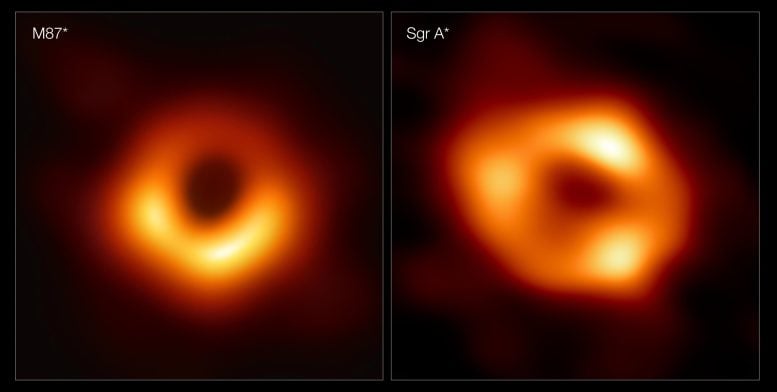
These panels show the first two images ever taken of black holes. On the left is M87*, the supermassive black hole at the center of the galaxy Messier 87 (M87), 55 million light-years away. On the right is Sagittarius A* (Sgr A*), the black hole at the center of our Milky Way. The two images show the black holes as they would appear in the sky, with their bright rings appearing to be roughly the same size, despite M87* being around a thousand times larger than Sgr A*. Credit: EHT Collaboration
“It is very exciting for ESO to have been playing such an important role in unraveling the mysteries of black holes, and of Sgr A* in particular, over so many years,” commented ESO Director General Xavier Barcons. “ESO not only contributed to the EHT observations through the ALMA and APEX facilities but also enabled, with its other observatories in Chile, some of the previous breakthrough observations of the Galactic center.”[2]
The EHT achievement follows the collaboration’s 2019 release of the first image of a black hole, called M87*, at the center of the more distant Messier 87 galaxy.
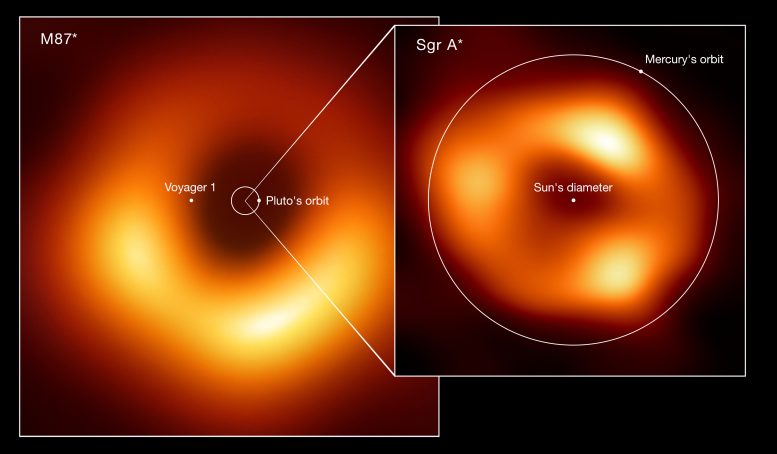
Size comparison of the two black holes imaged by the Event Horizon Telescope (EHT) Collaboration: M87*, at the heart of the galaxy Messier 87, and Sagittarius A* (Sgr A*), at the center of the Milky Way. The image shows the scale of Sgr A* in comparison with both M87* and other elements of the Solar System such as the orbits of Pluto and Mercury. Also displayed is the Sun’s diameter and the current location of the Voyager 1 space probe, the furthest spacecraft from Earth. M87*, which lies 55 million light-years away, is one of the largest black holes known. While Sgr A*, 27 000 light-years away, has a mass roughly four million times the Sun’s mass, M87* is more than 1000 times more massive. Because of their relative distances from Earth, both black holes appear the same size in the sky. Credit: EHT collaboration (acknowledgment: Lia Medeiros, xkcd)
The two black holes look remarkably similar, even though our galaxy’s black hole is more than a thousand times smaller and less massive than M87*.[3] “We have two completely different types of galaxies and two very different black hole masses, but close to the edge of these black holes they look amazingly similar,” says Sera Markoff, Co-Chair of the EHT Science Council and a professor of theoretical astrophysics at the University of Amsterdam, the Netherlands. “This tells us that General Relativity governs these objects up close, and any differences we see further away must be due to differences in the material that surrounds the black holes.”
This achievement was considerably more difficult than for M87*, even though Sgr A* is much closer to us. EHT scientist Chi-kwan (‘CK’) Chan, from Steward Observatory and Department of Astronomy and the Data Science Institute of the University of Arizona, USA, explains: “The gas in the vicinity of the black holes moves at the same speed — nearly as fast as light — around both Sgr A* and M87*. But where gas takes days to weeks to orbit the larger M87*, in the much smaller Sgr A* it completes an orbit in mere minutes. This means the brightness and pattern of the gas around Sgr A* were changing rapidly as the EHT Collaboration was observing it — a bit like trying to take a clear picture of a puppy quickly chasing its tail.”
The two supermassive black holes that have been observed by the EHT have considerable differences in mass. M87* is more than a thousand times larger than the black hole at the center of our galaxy, Sgr A*, which means that the gas goes around the latter much faster (on the timescale of minutes) than it goes around the former (on the timescale of days to weeks). Credit: C. M. Fromm (University Würzburg, Germany), L. Rezzolla (University Frankfurt, Germany), EHT Collaboration
The researchers had to develop sophisticated new tools that accounted for the gas movement around Sgr A*. While M87* was an easier, steadier target, with nearly all images looking the same, that was not the case for Sgr A*. The image of the Sgr A* black hole is an average of the different images the team extracted, finally revealing the giant lurking at the center of our galaxy for the first time.
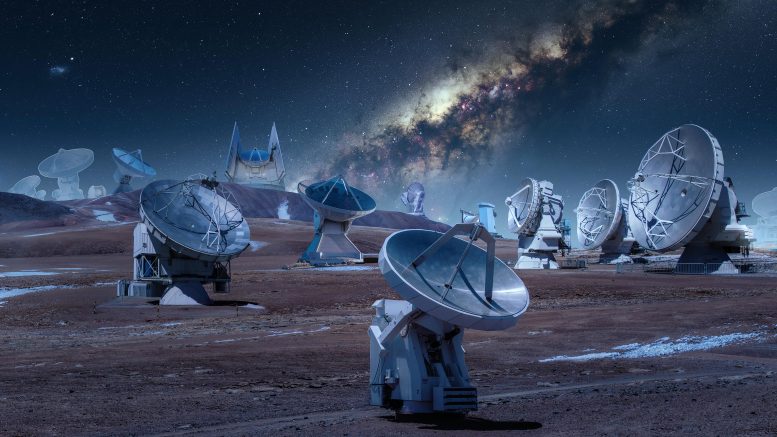
A montage of the radio observatories that form the Event Horizon Telescope (EHT) network, that was used to image the Milky Way’s central black hole, Sagittarius A*. These include the Atacama Large Millimeter/submillimeter Array (ALMA), the Atacama Pathfinder EXperiment (APEX), IRAM 30-meter telescope, James Clark Maxwell Telescope (JCMT), Large Millimeter Telescope (LMT), Submillimeter Array (SMA), Submillimeter Telescope (SMT) and South Pole Telescope (SPT).
The slightly transparent telescopes in the background, represent the three telescopes added to the EHT Collaboration after 2018: the Greenland Telescope, the NOrthern Extended Millimeter Array (NOEMA) in France, and the UArizona ARO 12-meter Telescope at Kitt Peak. These telescopes were added to the array after the 2017 observations of Sagittarius A*. Credit: ESO/M. Kornmesser. Images of individual telescopes: ALMA: ESO, APEX: ESO, LMT: INAOE Archives, GLT: N. Patel, JCMT: EAO-W. Montgomerie, SMT: D. Harvey, 30m: N. Billot, SPT: Wikipedia, SMA: S. R. Schimpf, NOEMA: IRAM, Kitt Peak: Wikipedia, Milky Way: N. Risinger (skysurvey.org)
The effort was made possible through the ingenuity of more than 300 researchers from 80 institutes around the world that together make up the EHT Collaboration. In addition to developing complex tools to overcome the challenges of imaging Sgr A*, the team worked rigorously for five years, using supercomputers to combine and analyze their data, all while compiling an unprecedented library of simulated black holes to compare with the observations.
Scientists are particularly excited to finally have images of two black holes of very different sizes, which offers the opportunity to understand how they compare and contrast. They have also begun to use the new data to test theories and models of how gas behaves around supermassive black holes. This process is not yet fully understood but is thought to play a key role in shaping the formation and evolution of galaxies.
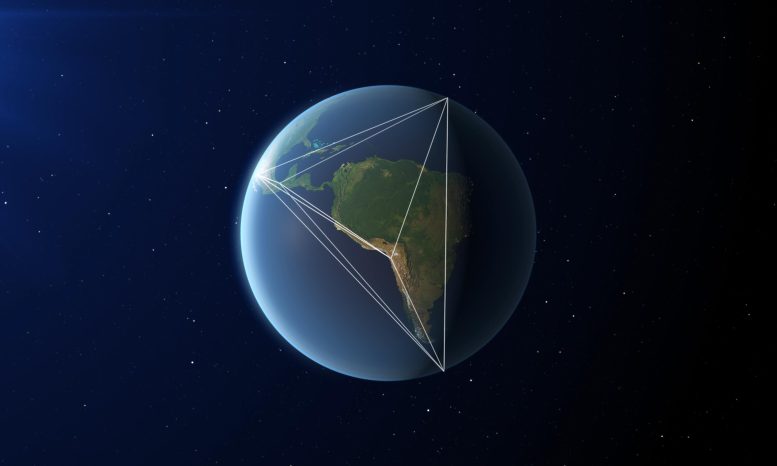
This image shows the locations of some of the telescopes making up the EHT, as well as a representation of the long baselines between the telescopes. Credit: ESO/L. Calçada
“Now we can study the differences between these two supermassive black holes to gain valuable new clues about how this important process works,” said EHT scientist Keiichi Asada from the Institute of Astronomy and Astrophysics, Academia Sinica, Taipei. “We have images for two black holes — one at the large end and one at the small end of supermassive black holes in the Universe — so we can go a lot further in testing how gravity behaves in these extreme environments than ever before.”

A global map showing the radio observatories that form the Event Horizon Telescope (EHT) network used to image the Milky Way’s central black hole, Sagittarius A*. The telescopes highlighted in yellow were part of the EHT network during the observations of Sagittarius A* in 2017. These include the Atacama Large Millimeter/submillimeter Array (ALMA), the Atacama Pathfinder EXperiment (APEX), IRAM 30-meter telescope, James Clark Maxwell Telescope (JCMT), Large Millimeter Telescope (LMT), Submillimeter Array (SMA), Submillimeter Telescope (SMT) and South Pole Telescope (SPT).
Highlighted in blue are the three telescopes added to the EHT Collaboration after 2018: the Greenland Telescope, the NOrthern Extended Millimeter Array (NOEMA) in France, and the UArizona ARO 12-meter Telescope at Kitt Peak. Credit: ESO/M. Kornmesser
Progress on the EHT continues: a major observation campaign in March 2022 included more telescopes than ever before. The ongoing expansion of the EHT network and significant technological upgrades will allow scientists to share even more impressive images as well as movies of black holes in the near future.
Notes
- The individual telescopes involved in the EHT in April 2017, when the observations were conducted, were: the Atacama Large Millimeter/submillimeter Array (ALMA), the Atacama Pathfinder EXperiment (APEX), the IRAM 30-meter Telescope, the James Clerk Maxwell Telescope (JCMT), the Large Millimeter Telescope Alfonso Serrano (LMT), the Submillimeter Array (SMA), the University of Arizona Submillimeter Telescope (SMT), the South Pole Telescope (SPT). Since then, the EHT has added the Greenland Telescope (GLT), the NOrthern Extended Millimeter Array (NOEMA), and the University of Arizona 12-meter Telescope on Kitt Peak to its network.
ALMA is a partnership of the European Southern Observatory (ESO; Europe, representing its member states), the U.S. National Science Foundation (NSF), and the National Institutes of Natural Sciences (NINS) of Japan, together with the National Research Council (Canada), the Ministry of Science and Technology (MOST; Taiwan), Academia Sinica Institute of Astronomy and Astrophysics (ASIAA; Taiwan), and Korea Astronomy and Space Science Institute (KASI; Republic of Korea), in cooperation with the Republic of Chile. The Joint ALMA Observatory is operated by ESO, the Associated Universities, Inc./National Radio Astronomy Observatory (AUI/NRAO), and the National Astronomical Observatory of Japan (NAOJ). APEX, a collaboration between the Max Planck Institute for Radio Astronomy (Germany), the Onsala Space Observatory (Sweden), and ESO, is operated by ESO. The 30-meter Telescope is operated by IRAM (the IRAM Partner Organizations are MPG [Germany], CNRS [France] and IGN [Spain]). The JCMT is operated by the East Asian Observatory on behalf of The National Astronomical Observatory of Japan; ASIAA; KASI; the National Astronomical Research Institute of Thailand; the Center for Astronomical Mega-Science and organizations in the United Kingdom and Canada. The LMT is operated by INAOE and UMass, the SMA is operated by Center for Astrophysics | Harvard & Smithsonian and ASIAA, and the University of Arizona SMT is operated by the University of Arizona. The SPT is operated by the University of Chicago with specialized EHT instrumentation provided by the University of Arizona.
The Greenland Telescope (GLT) is operated by ASIAA and the Smithsonian Astrophysical Observatory (SAO). The GLT is part of the ALMA-Taiwan project, and is supported in part by the Academia Sinica (AS) and MOST. NOEMA is operated by IRAM and the University of Arizona 12-meter telescope at Kitt Peak is operated by the University of Arizona. - A strong basis for the interpretation of this new image was provided by previous research carried out on Sgr A*. Astronomers have known the bright, dense radio source at the center of the Milky Way in the direction of the constellation Sagittarius since the 1970s. By measuring the orbits of several stars very close to our galactic center over a period of 30 years, teams led by Reinhard Genzel (Director at the Max –Planck Institute for Extraterrestrial Physics in Garching near Munich, Germany) and Andrea M. Ghez (Professor in the Department of Physics and Astronomy at the University of California, Los Angeles, USA) were able to conclude that the most likely explanation for an object of this mass and density is a supermassive black hole. ESO’s facilities (including the Very Large Telescope and the Very Large Telescope Interferometer) and the Keck Observatory were used to carry out this research, which shared the 2020 Nobel Prize in Physics.
- Black holes are the only objects we know of where mass scales with size. A black hole a thousand times smaller than another is also a thousand times less massive.
More information
This research was presented in six papers published today in The Astrophysical Journal Letters.
The EHT collaboration involves more than 300 researchers from Africa, Asia, Europe, North and South America. The international collaboration aims to capture the most detailed black hole images ever obtained by creating a virtual Earth-sized telescope. Supported by considerable international efforts, the EHT links existing telescopes using novel techniques — creating a fundamentally new instrument with the highest angular resolving power that has yet been achieved.
The EHT consortium consists of 13 stakeholder institutes; the Academia Sinica Institute of Astronomy and Astrophysics, the University of Arizona, the Center for Astrophysics | Harvard & Smithsonian, the University of Chicago, the East Asian Observatory, Goethe-Universitaet Frankfurt, Institut de Radioastronomie Millimétrique, Large Millimeter Telescope, Max Planck Institute for Radio Astronomy, MIT Haystack Observatory, National Astronomical Observatory of Japan, Perimeter Institute for Theoretical Physics, and Radboud University.
The Atacama Large Millimeter/submillimeter Array (ALMA), an international astronomy facility, is a partnership of ESO, the U.S. National Science Foundation (NSF), and the National Institutes of Natural Sciences (NINS) of Japan in cooperation with the Republic of Chile. ALMA is funded by ESO on behalf of its Member States, by NSF in cooperation with the National Research Council of Canada (NRC) and the Ministry of Science and Technology (MOST) and by NINS in cooperation with the Academia Sinica (AS) in Taiwan and the Korea Astronomy and Space Science Institute (KASI). ALMA construction and operations are led by ESO on behalf of its Member States; by the National Radio Astronomy Observatory (NRAO), managed by Associated Universities, Inc. (AUI), on behalf of North America; and by the National Astronomical Observatory of Japan (NAOJ) on behalf of East Asia. The Joint ALMA Observatory (JAO) provides the unified leadership and management of the construction, commissioning, and operation of ALMA.
APEX, Atacama Pathfinder EXperiment, is a 12-meter diameter telescope, operating at millimeter and submillimeter wavelengths — between infrared light and radio waves. ESO operates APEX at one of the highest observatory sites on Earth, at an elevation of 5100 meters, high on the Chajnantor plateau in Chile’s Atacama region. The telescope is a collaboration between the Max Planck Institute for Radio Astronomy (MPIfR), the Onsala Space Observatory (OSO), and ESO.
The European Southern Observatory (ESO) enables scientists worldwide to discover the secrets of the Universe for the benefit of all. We design, build and operate world-class observatories on the ground — which astronomers use to tackle exciting questions and spread the fascination of astronomy — and promote international collaboration in astronomy. Established as an intergovernmental organization in 1962, today ESO is supported by 16 Member States (Austria, Belgium, the Czech Republic, Denmark, France, Finland, Germany, Ireland, Italy, the Netherlands, Poland, Portugal, Spain, Sweden, Switzerland, and the United Kingdom), along with the host state of Chile and with Australia as a Strategic Partner. ESO’s headquarters and its visitor center and planetarium, the ESO Supernova, are located close to Munich in Germany, while the Chilean Atacama Desert, a marvelous place with unique conditions to observe the sky, hosts our telescopes. ESO operates three observing sites: La Silla, Paranal, and Chajnantor. At Paranal, ESO operates the Very Large Telescope and its Very Large Telescope Interferometer, as well as two survey telescopes, VISTA working in the infrared and the visible-light VLT Survey Telescope. Also at Paranal ESO will host and operate the Cherenkov Telescope Array South, the world’s largest and most sensitive gamma-ray observatory. Together with international partners, ESO operates APEX and ALMA on Chajnantor, two facilities that observe the skies in the millimeter and submillimeter range. At Cerro Armazones, near Paranal, we are building “the world’s biggest eye on the sky” — ESO’s Extremely Large Telescope. From our offices in Santiago, Chile we support our operations in the country and engage with Chilean partners and society.
References:
- Main papers:
- Paper I: The Shadow of the Supermassive Black Hole in the Center of the Milky Way
- Paper II: EHT and Multi-wavelength Observations, Data Processing, and Calibration
- Paper III: Imaging of the Galactic Center Supermassive Black Hole
- Paper IV: Variability, Morphology, and Black Hole Mass
- Paper V: Testing Astrophysical Models of the Galactic Center Black Hole
- Paper VI: Testing the Black Hole Metric
- Supplementary papers:
- Selective Dynamical Imaging of Interferometric Data
- Millimeter Light Curves of Sagittarius A* Observed during the 2017 Event Horizon Telescope Campaign
- A Universal Power Law Prescription for Variability from Synthetic Images of Black Hole Accretion Flows
- Characterizing and Mitigating Intraday Variability: Reconstructing Source Structure in Accreting Black Holes with mm-VLBI

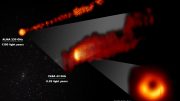

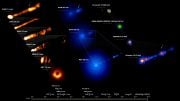
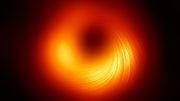
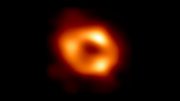
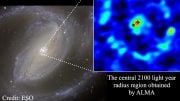
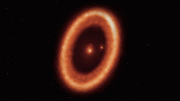
Another great image. Still no science though. NASA has taught a whole new generation of science bums that the public prefers pictures over science. Why do science. 10 billion for a couple pictures a week. Easy peasy. Easiest paycheck ever.
Is M87 much older than Sagittarius A? Is that why it is bigger? Because it has had more time to accumulate mass? Or is it because there was more mass available in M87 to begin with? Or was it both?
@Carey I think that main culprit for M87* being bigger is that it had more material to eccrete. But we don’t know the origin of SBH from the galactic centers. There are some SBH formed not that long ago after big bang and they have masses in billion times more than our Sun range.
A common misconception (even among physicists!) I noticed (again & again!) is this:
“Einstein refused to believe in physical existence of Black Holes!”
No, Einstein refused to believe in physical existence of singularities (zero-size/infinite-density objects!) & he was actually absolutely right, IMHO!
(As there is nothing really hard to believe about a star/object w/ so much mass that its escape velocity is greater than speed of light! Such a possibility was considered even long before Einstein!)
First of all, IMHO, thinking/assuming Black Holes contain singularities (which have zero-size & infinite-density!) is utterly ridiculous!
(Imagine 2 zero-size(!) objects: one of them has the mass of a large star(!) & the other has the mass of a galaxy! This really makes any sense?)
I think progress in theoretical physics is pretty much stuck today, because of this kind of physically out-of-touch thinking!
Assuming that, if anything mathematically/geometrically possible, it is also physically possible!
Assuming that, our universe is made of perfect/ideal mathematical/geometric objects, like 0D points and/or 1D rings/strings etc!
Just like when Kepler wasted many years trying to explain whole celestial mechanics using 5 (perfect!) Platonic Solids!
BHs should/must be made of particles, just like everything else in our universe!
& guess what?: There is only 1 possible/suitable particle then: Planckion!
A particle that has min possible size (Planck length) & max possible density (Planck mass) & so can never be crushed or compressed any further!
A particle that is itself is a micro-BH! (Realize, for example, a Neutron Star is just like a giant neutron!)
A particle that is unstable individually but stable when part of a star (so just like neutron)!